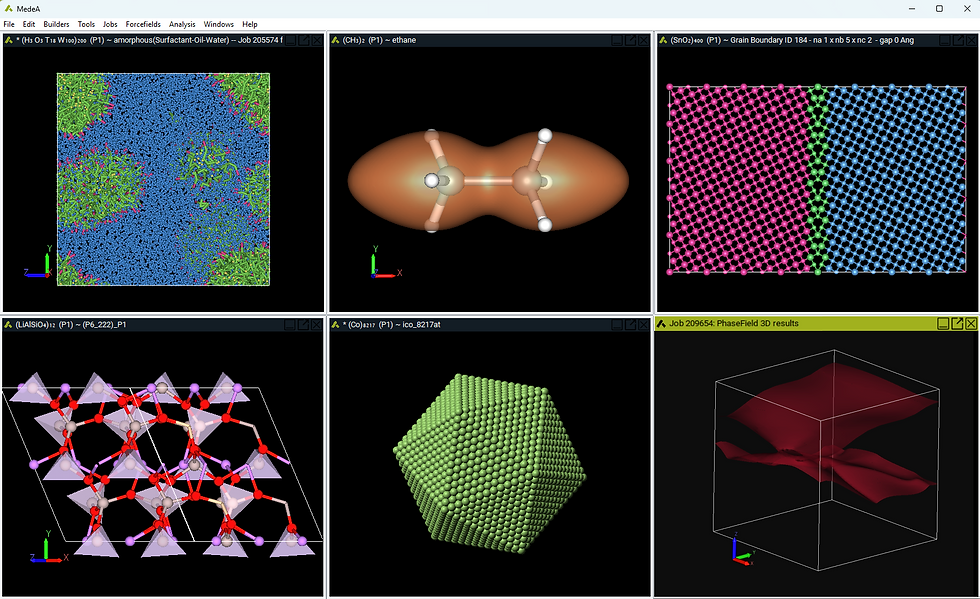MedeA Software Release MedeA 3.2 -- Expanding!
- Katherine Hollingsworth
- Dec 8, 2020
- 3 min read

Materials Design, Inc. Announces the Release of MedeA 3.2.
"MedeA 3.2 is an exceptional release." said Dr. Erich Wimmer, Chief Scientific Officer and Chairman of the Materials Design Board. Dr. Wimmer continued, "Our development and product management teams have added capabilities to MedeA that greatly expand the simulator's realm."
The integration of the MSI Phase Diagrams database in MedeA provides access to thousands of validated phase diagrams. Together with over one million crystal structures accessible through the InfoMaticA module of MedeA, users can build realistic models with a few mouse clicks and perform state-of-the-art computations on those models.
VASP 6 in MedeA 3.2 includes excitonic effects in optical spectra; it offers facile access to the low-scaling ACFDT/RPA and computes heats of formation, thus providing unprecedented accuracy and utility.
With the new implementation of EAM potentials in MedeA GIBBS, users can now apply Monte Carlo methods to metallic systems to study phenomena such as hydrogen segregation to grain boundaries.
A powerful new feature is the automatic coarse-graining from all-atom to mesoscale models, thus enabling users to perform simulation on systems such as complex fluids and polymers at expanded length and time scales.
In response to input from our customers, the development team has expanded the analysis capabilities, extended forcefields after careful validation, and provided thermodynamic information for systems based on vibrational analysis, in addition to completing a large array of infrastructural enhancements.
Dr. Wimmer added: "With this release, we are continuing to expand the breadth and depth of MedeA to meet the ever-growing challenges of designing and optimizing materials used in areas including energy technologies, functional polymers, and advanced alloys. These developments reflect the deep commitment of Materials Design to serve its expanding user community. It is a real privilege to be a part of the unique team that created this release."
Description of MedeA 3.2 New Features and Enhancements
General
Improvements in structure 3D viewer:
+Line antialiasing for high quality cell and line draw views
+Updated perspective projection for depth perception
Numerous documentation enhancements, updates, and new tutorials
JobServer job imports have been enhanced
Enhanced graph plot file export functionality
Added property variables for use in Flowcharts
Enhanced labelling
Databases
New MSI Phase Diagrams Database providing high-quality, evaluated phase diagrams, and related constitutional data
Builders and Editors
Thermosets:
+Support crosslinks between multiple types of site
+Optional user-controlled connection probabilities
Mesoscale:
+Perform mapping of a coarse-grained onto an atomistic system
Nanoparticles:
+Improved algorithm, reducing particles build times for large systems
Engines
MedeA VASP:
+Automated calculation of energy of formation (VASP 6)
+Excitonic effects in optical spectra from the model Bethe-Salpeter approach based on a model dielectric function
+Use of ScaLAPACK through the Advanced/Restart tab
+Listing of optical functions on a regular wavelengths grid in Job.out
+Optical functions output as variables in workspace for use in Flowcharts
+Addition of kinetic contribution to the average pressure obtained from molecular dynamics simulations
MedeA LAMMPS:
+Distribution analysis available in LAMMPS Analysis
+Group analysis available in LAMMPS Analysis
+Pair Correlation analysis available in LAMMPS Analysis
MedeA GIBBS:
+Enable the use of mesoscale forcefields (including MARTINI and SPICA)
+Enable the use of EAM forcefields - allowing simulation of e.g. hydride formation
+Use of 1-2/1-3/1-4 interactions as defined in the forcefield file (frc)
MedeA MOPAC:
+Updated version from Professor Jimmy Stewart
Property Modules
MedeA QT:
+New QT version: v1.2.31 on linux and v1.2.30 on windows
+Interactive correlation plot updates
+Residuals plot for all correlations
+All items on the Edit menu are disabled for the Models tab
+Green check marks and gray hint boxes are restored on column menus for the Training Set tab
+Plot menu items no longer appear on column menus for the Training Set tab
+Plot menu items are enabled only for "Model N" columns on the Models tab
+Additional logging capabilities have also been incorporated
MedeA Phonon:
+Enable graphical display of thermodynamic functions, vibrational and electronic occupation contributions
+Updated support for valence forcefields with LAMMPS
MedeA MT:
+Enable graphical display of thermodynamic functions
Forcefields
PCFF+: Forcefield extensions based on validated analysis for:
+Extensions for ketones
+Enhanced atom typing rules for selected systems
Added GAFF (General AMBER forcefield, for organic molecules)
Added ReaxFF/CHONFClSi.frc
Updated MEAM descriptions
Analysis Tools:
New GUI for assembling and plotting thermodynamic functions (from Phonon and MT)
Additional handling of trajectory animations
Automated video creation for animations
Fine control over frame selection for animations



Comments